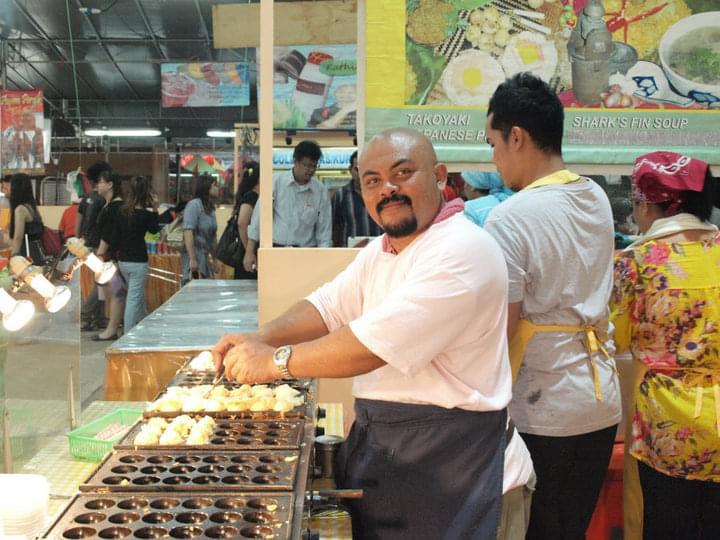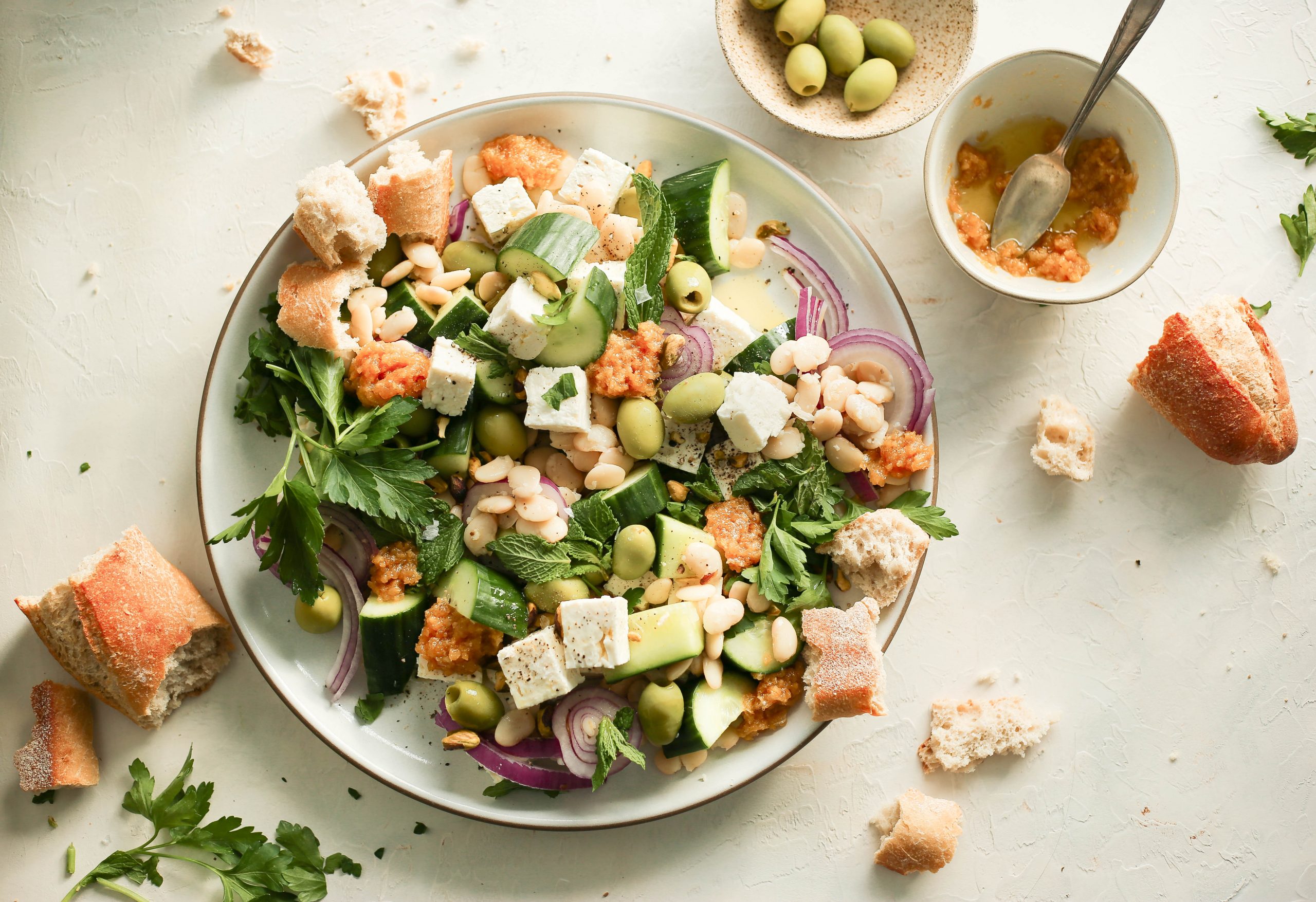Opportunities vs overheads: Vendors share perspectives on running a booth at pop-up events
Despite high rent, low footfall and bad management, small businesses are still attracted to join as vendors at open-air markets and pop-up events.
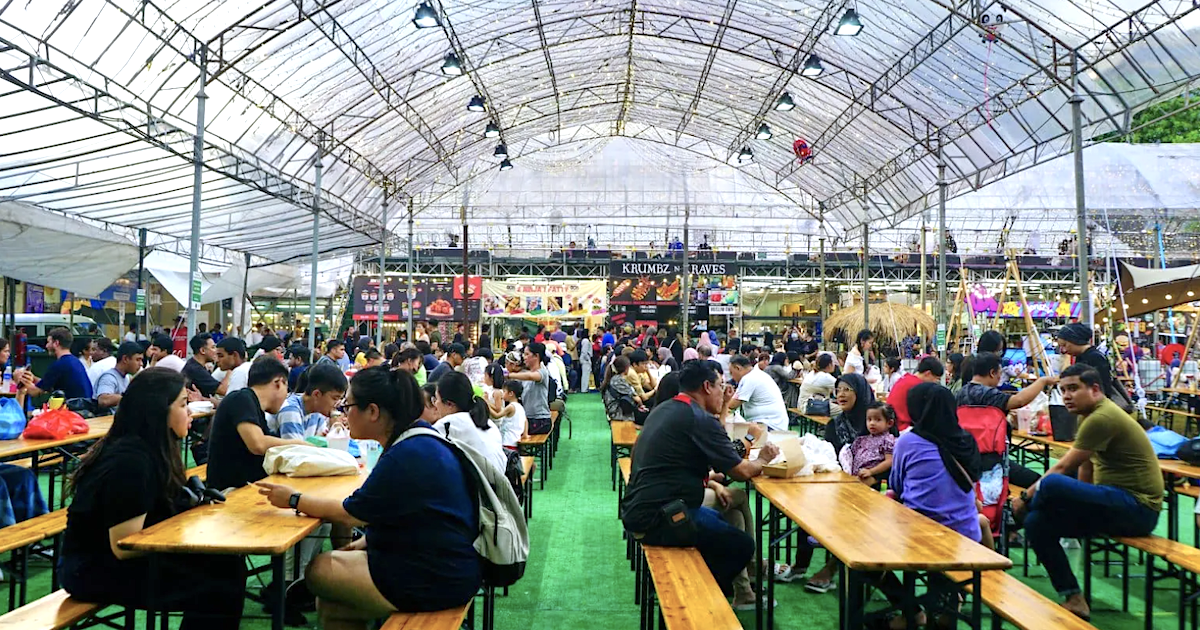
Three Missy was casually born during a lunch break. While chatting about the upcoming Geylang Serai Ramadan Bazaar early this year, three colleagues — Nuratiqah, Ratnawati, and Nurzalina — had a fun thought to join as a vendor.
What if they give Tahu Bergedil — a deep-fried snack wrapping minced beef and mashed potatoes with tofu skin — a seafood twist and sell it alongside garlic parmesan and Korean-style wings?
It was a stroke of genius that they couldn’t resist turning into reality. It didn’t take long for the trio to get into action too, although they all work in the healthcare sector with gruelling 12-hour shifts.
They soon set their eyes on a prime spot outside Kinex shopping mall in Paya Lebar. However, they were notified by the bazaar organiser, just days before the opening, that no cooked food is permitted to be sold in the area.
Hence, they had to quickly settle on a replacement beside Tanjong Katong Complex instead. As seasoned healthcare staffs who had soldiered through the COVID-19 pandemic, the hiccup wasn’t the hardest bit to swallow.
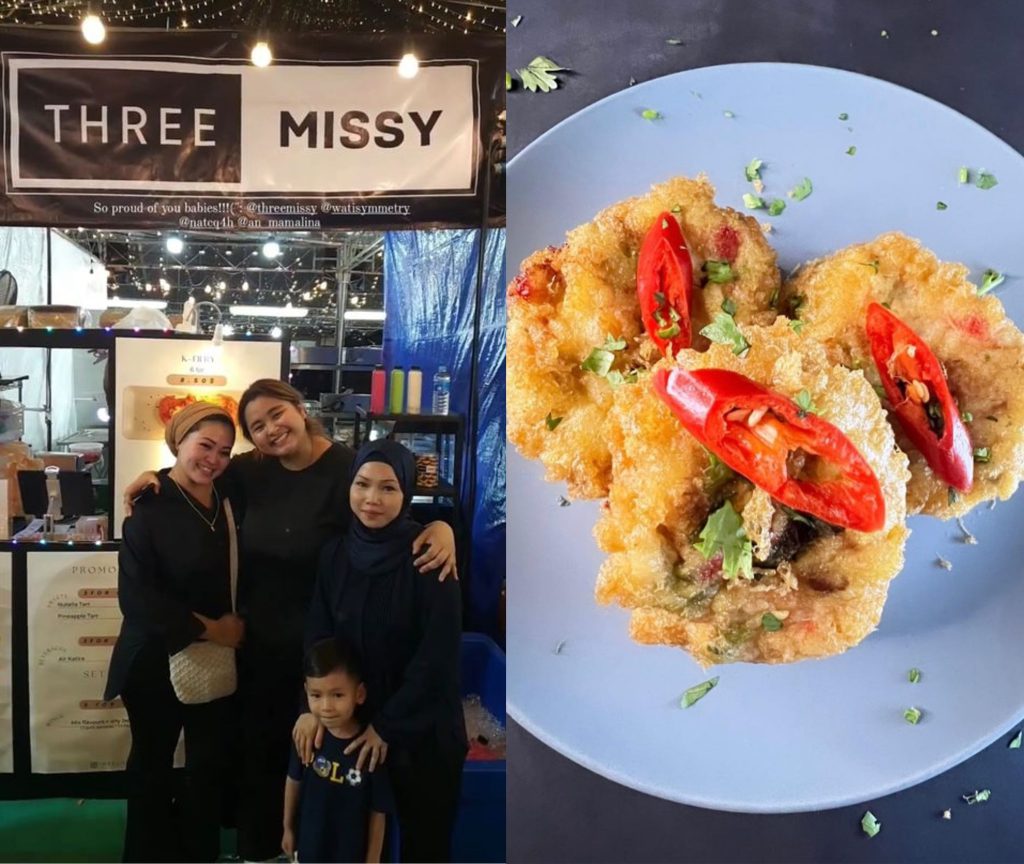 (Left to right): Nurzalina, Nuratiqah, and Ratnawati, co-founders of Three Missy and Tahu Bergedil with a seafood twist / Image credit: Three Missy
(Left to right): Nurzalina, Nuratiqah, and Ratnawati, co-founders of Three Missy and Tahu Bergedil with a seafood twist / Image credit: Three MissyInstead, it’s the exorbitant rent that’s slowly draining away their enthusiasm. Indeed, high rental prices outshine the vibrant atmosphere and delectable food options, taking centrestage at some of the recent outdoor markets and pop-up events happening in Singapore.
This is particularly the case for the ongoing Geylang Serai Ramadan Bazaar. With the rental for each F&B booth priced between S$15,000 and S$25,000 (excluding utilities and manpower costs), setting up a stall has become an uphill battle.
The charm of pasar malam and pop-up events
Nevertheless, some small business owners that I’ve spoken with, were not deterred at all by the cutthroat world of makeshift stalls. They regarded them as good opportunities to kickstart their entrepreneurial journey and even scale their trades, mainly because of the hype and vibe.
“You could see and feel that people are coming to Geylang Serai to enjoy themselves. The crowd is just amazing,” said Hanifayana, co-founder of Charkoi. Charkoi is the local pioneer of Yu Char Kway Manis – a fusion snack comprising deep-fried flour dough crowned with a variety of sweet toppings, ranging from Nutella and Oreos, to cheese and condensed milk.
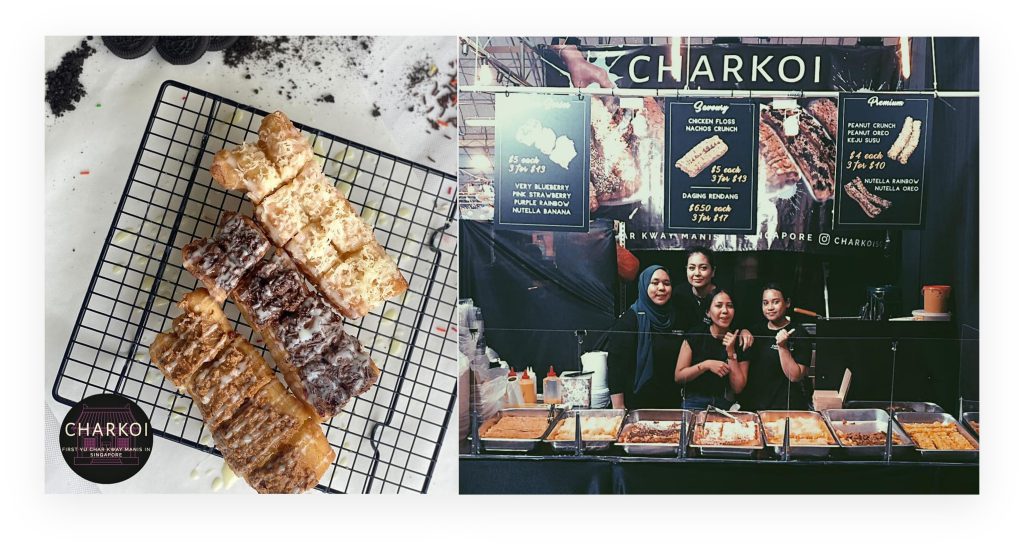 Charkoi is the local pioneer of Yu Char Kway Manis / Image credit: Charkoi
Charkoi is the local pioneer of Yu Char Kway Manis / Image credit: CharkoiEmika, co-founder of 2 Ninja 1 Fatty selling grilled seafood, tornado potato, and hotdog tornado potato, echoed the above sentiment, adding that the Geylang Serai crowd was “exceptionally strong, especially on the weekend when the bazaar closes at 12am.”
Some also see outdoor markets and fairs as alluring alternatives to the repetitive lineup of familiar brands in the air-conditioned neighbourhood malls.
Zur’ Ain Azneeta, co-owner of takoyaki stand De Chuchu’s noted that Geylang Serai used to be the only place in Singapore that holds an annual Ramadan bazaar. People remember this over the years so coming back for a visit becomes customary. “They know they can find something different here,” she said.
Others believe pop-up events, notably the targeted ones, are a conglomerate of the like-minded.
Crystal, founder of Oatcrafts, which specialises in handmade polymer clay earrings, custom illustrated keychains, and other accessories said regular pop-ups like Public Garden and Boutique Fair attract people who genuinely like local handicrafts and designs.
They are more willing to spend and share about their purchases on social media. “You know they are not just after the food,” she quipped. Sadly, the beacon of optimism does not immune anyone to the realities of commerce.
Surviving the unsurprisingly high rental
“We were mentally prepared to pay about S$17,000 for the stall when the the price was publicly announced,” shared Three Missy founders. “But right now, it feels like we are working ourselves off just to cover the rent alone. It’s so high that breaking even proves to be extremely difficult.”
Meanwhile, 2 Ninja 1 Fatty’s Emika were not happy with the recently-held Chatuchak Singapore Night Market because the torrential downpour had somewhat dampened the foot traffic.
As they just started venturing into the F&B industry this February, they thought there was no need to limit themselves to one event. This prompted them to join the Geylang Serai bazaar, snagging one of the last few available stalls.
Still, Emika admitted that paying S$20,000 rent for 30 days felt like a risky game of chance for a new business.
 2 Ninja 1 Fatty’s specials: Hotdog tornado potato and grilled seafood / Image credit: 2 Ninja 1 Fatty
2 Ninja 1 Fatty’s specials: Hotdog tornado potato and grilled seafood / Image credit: 2 Ninja 1 FattySome vendors resorted to setting up multiple stalls throughout the bazaar to cope with the high rental. This means visitors are likely to encounter the same offerings time and again, but Zur’ Ain Azneeta lamented she did not have a choice and had to play along with it.
She operated several stalls across Geylang Serai and marked up the prices of food items just to break even in 2019, when she paid S$14,000 for rental. As the rent skyrocketed this year, she had opted out of the Geylang Bazaar and set up a booth at the Masjid Al Islah Mosque in Punggol instead, paying a total of S$1,700 for 25 days.
For Hanifayana, she told me she has already spent around S$15,000 on rent back in 2019. This year, she paid close to S$19,000, which stopped her from thinking about making a profit. “We just hope to break even at the least.”
To stay afloat, Charkoi spiced up their menu with new items like cheese corndog and grape milk tea that would cater to a more diverse clientele. They also operate an online arm for those who prefer to order online to avoid the crowd.
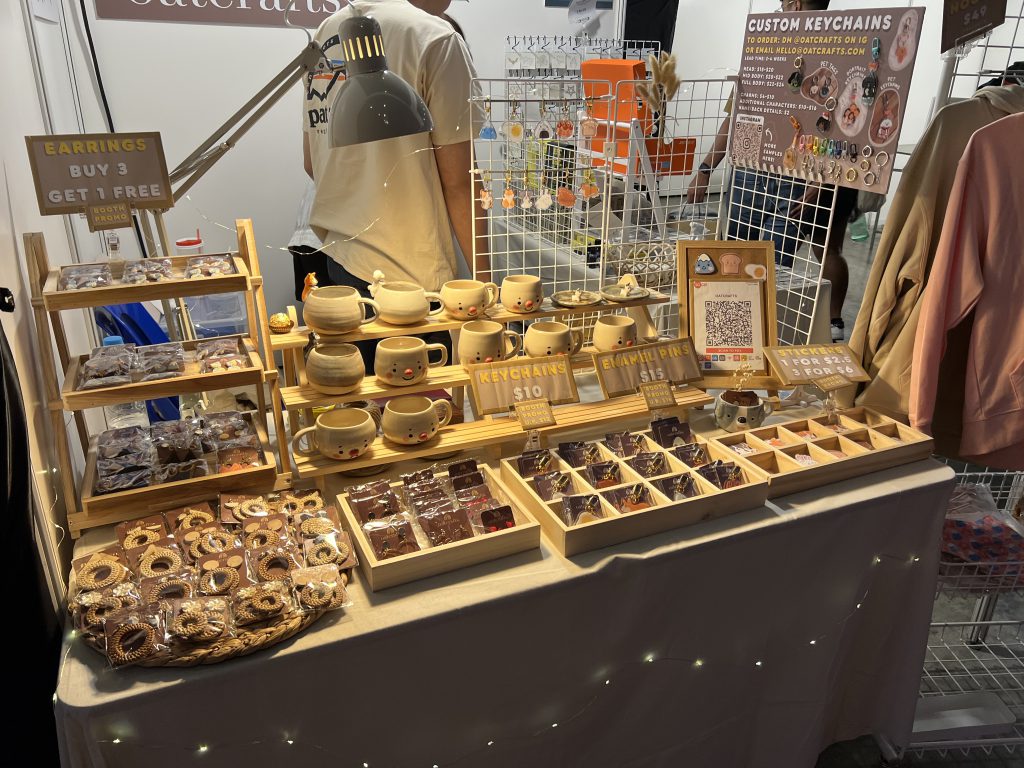 Crystal shared a booth with her friend at Artbox 2023 / Image credit: Oatcrafts
Crystal shared a booth with her friend at Artbox 2023 / Image credit: OatcraftsOn the other hand, Crystal splits the rent at creative pop-up market Artbox 2023 with her friend. In total, she paid over S$800 for half a booth over the two weekends at Singapore Expo.
Event organisers have no vendors in mind
While Crystal managed to make a profit due to the massive publicity of the event made by the organiser, the operating hours were long — she was mostly standing for 12 to 13 hours straight.
Furthermore, Crystal felt the organiser had not done enough to help fellow vendors. For one, if vendors would like to get additional help at the booth, they would have to buy vendor passes that are priced the same as public tickets (S$6).
Overall, the communication was poor and there were many impromptu notices. She cited that vendors were only informed about a compulsory media event and the set-up time at the very last minute. There was also no follow-up to queries, and staff were generally jaded and unhelpful.
“All these, coupled with the steep rent, makes us wonder if it is worth the effort of setting up a booth at all, especially since many designers like me are doing all the work – crafting, packaging, marketing, and customer support – alone,” said Crystal.
Hanifayana also expressed that the Geylang Serai Bazaar organiser could have done more in terms of publicity and attracting more people. “We anticipated the same [turnout], if not a larger crowd, because this marks as a comeback after the COVID-19 pandemic,” she said. “I think we were blindsided.”
“Nowadays, night markets and pop-up events are so common that people don’t find them special anymore — unless you are selling unique food items, or they taste so good that people are willing to queue for them,” added Zur’ Ain Azneeta. “Otherwise, you will never be competitive enough.”
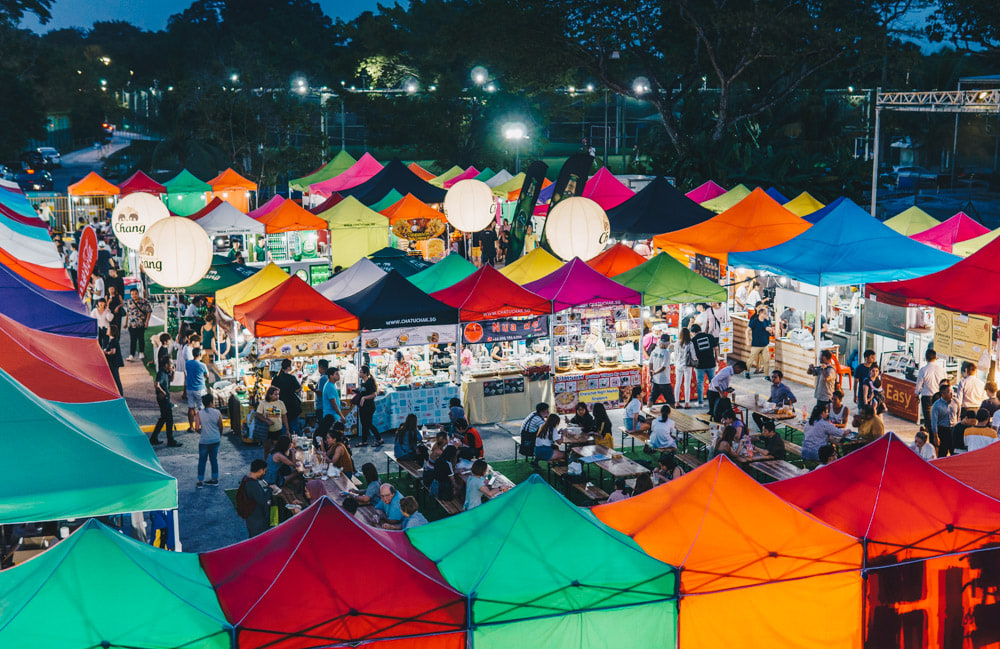 Image credit: Klook.com
Image credit: Klook.comIt’s not farfetched to say that the organisers perceive vendors as mere pawns in a business venture, and are unconcerned about losing them. Even if one vendor backs out, they are confident that new ones will readily step in to take their place.
Consequently, the well-being and profitability of the vendors are not a priority for anyone other than the vendors themselves.
“We will definitely look around other locations that can yield more profit, so we don’t need to worry about a business that’s not making money,” Hanifayana said.
“Honestly, this is tough for me and my partner,” said Three Missy founders. “We hope there will be some changes in the future so young and small businesses like us can earn something. However, we are keen to keep our ‘baby’, opening up stalls in other locations outside Geylang Serai and the Ramadan period.”
Featured Image Credit: Confirm Good

 Tfoso
Tfoso 